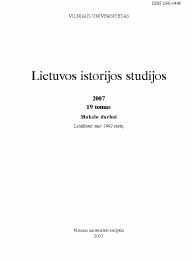MUGËS IR JU VAIDMUO PREKYBOS STRUKTÛROJE VILNIAUS IR KAUNO GUBERNIJOSE 1861–1914 METAIS
FAIRS AND HIS ROLE IN PATTERN OF TRADE IN VILNIUS AND KAUNAS PROVINCE IN 1861–1914
Author(s): Aelita AmbrulevičiūtėSubject(s): History
Published by: Vilniaus Universiteto Leidykla
Summary/Abstract: Vilnius and Kaunas province didn’t have large-scale fairs. Traditionally, they lasted 1–2 days, sometimes – coupe weeks, rarely – a month. Each fair had its own traditions and specialization. Before appearance of railway and factory production, fairs played a very important role of wholesale trade: the key transactions were carried out through fairs system. Tendencies of fairs’ decline appeared after the economic reforms in 1861. With Lithuanian involvement into interlocal market of trade, was growing the importance of foreign and interregional trade, and increasing the network of domestic trade. However, quantitative spread of the latter was decreasing turnover of separate markets. Also, expansion of fairs network from the eighties of XIX century noticeably decreased the trade turnovers of a separate fair and decreased the importance of fairs as a form of the wholesale trade. Such phenomenon should be explained not just by the economical backwardness of the country, domination of agrarian trade, but by the modernization of structures of transport, production and commerce. With the expansion of factory production and increased extent of production after 1861, seasonal prevailence of fairs and their locality were not meeting the modern requirements for realization of goods. Permanent industry trade of consumer goods was creating modern outlet forms. Because of the specifics of trade in fairs, wholesale of factories goods didn’t spread here even since the middle of the eighties, when the number of factories and the amount of industrial goods were increasing. Just a small part of industrial goods for consumers needs were getting into the fairs through retail trade system, which was creating its own network of realization of goods in seventies-eighties of XIX century. Since the end of XIX century, the main goods assortment and the biggest part of trade turnover in Vilnius and Kaunas province fairs were the products of agriculture. Laying of railways improved communication, constant trade relationship with the industrial centers began, which revitalized the interregional transportation of goods from / into aboard. With the permanent goods realization possibilities, the industrial enterprises did not have to wait for the coming fairs. Since then, industrial products were soled out through the modern permanent outlet system of goods (wholesale warehouses and special shops) and the products of agriculture in fairs and through special networks of wholesale warehouses, established for agricultural products. The latter took some part of fairs outlet and quantitatively decreased the transportation of goods into fairs. Such differentiation of the outlet for goods caused a greatly decreased of the trade turnover in fairs, their role in the trade structure fell down and their importance was reduced just to the local level.
Journal: Lietuvos istorijos studijos
- Issue Year: 2007
- Issue No: 19
- Page Range: 24-40
- Page Count: 17
- Language: Lithuanian

